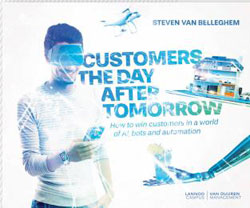We have now entered the third phase of digital evolution, and it is changing the behaviour and expectations of customers, fast.
 The first phase was all about the internet, and making information accessible. The second phase was all about mobile and social media, and how they connect people. This third phase is about data and Artificial Intelligence, and how it is creating a world of fast-than-real-time customer service, intuitive user interfaces and the ultimate in customer convenience.
The first phase was all about the internet, and making information accessible. The second phase was all about mobile and social media, and how they connect people. This third phase is about data and Artificial Intelligence, and how it is creating a world of fast-than-real-time customer service, intuitive user interfaces and the ultimate in customer convenience.
Many of the world’s leading companies have already moved from a ‘mobile-1st’ to an ‘AI-1st strategy,’ but how can all other businesses transform the power of automation and artificial intelligence into customer benefits? Now an innovative new book, Customers The Day After Tomorrow, has been published to guide you through this new phase of digitisation, help you combine technology with your invaluable human element and keep your company ahead of the game in ‘the day after tomorrow.’
The author, Professor Steven van Belleghem is a best-selling and award winning author, and is widely regarded as one of Europe’s thought-leaders in the field of customer engagement in the digital world. In his new book he not only shares his own insights, but also exclusive interviews with some of the world’s leading experts in data, AI, automation and technology to reveal how they are shaping the future of marketing, the workplace, customer behaviour and wider society.
Presented in a visually engaging and very accessible style, Customers The Day After Tomorrow uses fascinating real life examples to demonstrate how innovative organisations are leading the way and disrupting markets. It explores technologies like driverless cars, Blockchain, virtual assistants, Augmented Reality and bots in a way that will help even technophobes to think about the future of relationships between companies and customers, and start preparing for ‘the day after tomorrow’ today.
Bringing the book to life with AR
Not only does Customers The Day After Tomorrow explain the practical benefits of emerging technologies, it also demonstrates them, as one of the first books to use Augmented Reality. By integrating the Aurasma app, readers can view the book through their smartphone or tablet and see the pages come to life.




